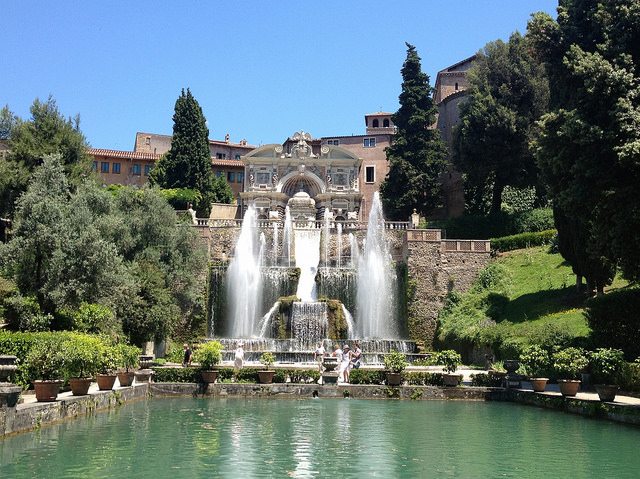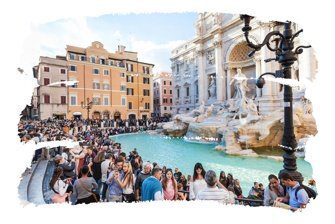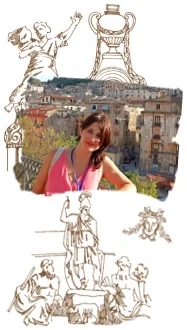Let’s visit Tivoli?
A day to visit Tivoli and its famous villages – Vila Adriano, Vila d´Este and other charming places – it can be enough, all you have to do is organize your time! Tivoli is definitely a destination to be considered by tourists! To better understand its beauty here it is a brief notion of its origins, which I have prepared for those who dream of making a great trip to a wonderful place! Is it worth visiting Tivoli? I say yes and I am sure you will not regret it. Stay with us and make the best of boot shaped country! Here at Your Travel to Italy with Ana Patricia you make the trip of your dreams!!! ALSO: see our “Accommodation in Italy – Tips for your holidays!”
1) Let’s visit Tivoli? VILLA ADRIANA (HADRIAN VILLAGE)
Let’s consider the first of the three villages that made Tivoli even more attractive! We are talking about the beautiful Villa Adriana, the “Hadrian’s Village”. If you have a free day, it is worth traveling 25 km outside the center of Rome and going to visit “Villa Adriana”. It is the largest village that belonged to the Roman emperor, Hadrian, and attests to the extraordinary level of skill achieved in Roman architecture.
Imperial Residence
Built, in fact, by Emperor Hadrian as an imperial residence, it is accessed through two streets (Tiburtina Street and Prenestina Street) or sailing on the Aniene River. The emperor wanted to reproduce those monuments that, during his many travels, especially in Greece, had fascinated him, especially the Pecile, Canopus, Academia and the Colleges.
Pecile Garden
Pecile is a large garden surrounded by a balcony with a central swimming pool, used for walks during summer and winter. Following a path full of a series of spa buildings, we arrive at Canopus (name of an ancient city connected to Alexandria by a navigable canal). It is a long bed of water decorated with columns and statues, culminating in a temple covered with a carnation dome.
Spas – The Great Baths and Small Baths
In line with the Canopus valley they climb the remains of two spas: The Great Baths and the Small Baths. These were equipped with outdoor ice rooms and a round room with coffered vault where five large windows were opened. Decorated with precious stucco, these buildings were dedicated to the imperial family and their guests. The Great Baths, reserved for Villa residents, had a heating system under the floor and an imposing circular room used as a steam room. Noteworthy: the large dome of the central hall is still in perfect balance, despite the collapse of one of the four support points.
Inside the House
Undoubtedly, the places to visit inside the house are many and among them we can remember the Academy, the Stadium, the Imperial Palace, the Philosophers Hall, the Greek theater and the Golden Square. The latter is a majestic structure that had characteristics of “representation” and contemplated a large balcony decorated with fine stucco. Finally, among the noble buildings, it is worth visiting the beautiful Maritime Theater, a type of island with an Ionic colonnade, surrounded by a canal. Indoors, there was the emperor’s private room, which is accessed through a movable bridges system.
2) Let’s visit Tivoli? VILLA D´ESTE (D’ESTE VILLAGE)
The other beautiful house that will delight you is “Villa d’Este” (D’Este Village), ordered in 1550 by Cardinal Ippolito II D’Este. This village is famous for its artistic wonders and, in particular, for the numerous characteristics of the water that transport the visitor in a palace of yore, to revive this house in the magnificence of the courts of Ferrara, Rome and Fontainebleau. The impressive concentration of caves and fountains is a model much copied for the architecture of European gardens in the Mannerist and Baroque styles. Of particular interest are the rooms on the main floor of the palace decorated and painted by a large group of artists of late Roman Mannerism period.

Villa d´Este Garden
Occupying a prominent place in the beautiful garden of Villa d’Este, designed by the painter and architect Pirro Ligorio, divided into terraces, stairs, paths and tracks, the garden resembles the Hanging Gardens of Babylonia, while the water supply system, with an aqueduct and a tunnel under the city, evokes the wisdom of Roman engineering.

Its Fountains
Certainly the hundreds of fountains that line the avenue, over hundreds of meters, have a great visual impact. Under the Avenue of the Hundred Fountains, there is the spectacular Fountain of Dragons which, due to its central location, is the heart of the park. Legend has it that this fountain was built in one night, in September of 1572, as a tribute to Pope Gregory XIII, who was a guest of the house. Certainly the most impressive and spectacular fountain in Villa d’Este is the Fountain of Neptune, originally built by Gian Lorenzo Bernini and which was restored in the 20th century. Given its beauty, it has become a model for many 18th century fountains.

Ticket Prices: 8,00 Euros
BOOK ONLINE TICKET CLICKING HERE!
3) Visit Tivoli? VILLA GREGORIANA (GREGORIAN VILLAGE)
The Villa Gregoriana Park was built in 1835 by Pope Gregory XVI. It is a very special romantic garden whose main attraction is the large waterfall, created by the diversion of the river bed Aniene, ruined by the flood of 1826. The old river bed has become a destination for walks, now daring, and fascinating.

About the Villa
Gregorian Village became a center of flow-cultural nature that starred travelers, artists, nobles and kings. Since 2002, the park has been given to FAI, which supervised the restoration necessary for its reopening to the public. Ticket price: 7 Euros.
Useful information
- Villa Adriana: Villa Adriana Street – 00019 Tivoli – Phone number: +39 06/39967900
- Villa D’Este: Trento Square, 5-00019 Tivoli – Phone number: +39 199 766 166 (from Italy); +39 0412719036 (from abroad), Fax: +39 0412770747 – E-mail: @ villadestetivoli teleart.org / info@ villadestetivoli.info
- Important: Reservation is required.
Let’s get to know a little about the history of Tivoli?
Tivoli’s original name is Tibur. The winery was founded in 1215 B.C. and the settlement was founded on the left bank of Aniene, where the Acropolis was founded with its temples, still admired in their entire splendor. In the first century BC it became a prestigious place for the homes of Roman noble families. In the 2nd century BC Emperor Hadrian built the magnificent Villa Adriana, defined by the poet Virgílio with the title “Tibur Superbum” title that is still today on the city’s coat of arms. How to go to Tivoli from Rome?
Location
The city of Tivoli is located on the slopes of the mountains along the Tiburtini course, in a position that dominates the plain below, and since ancient times the abundance of water and the climatic and environmental conditions have favored human settlement. Where to stay in Rome?
Aniene Valley was the only access to the Roman countryside for those coming from Abruzzo and Marsica and has been inhabited since the Neolithic period. Initially, the area was affected by a “transhumance” passage, that is, the transit of pastors who moved to fertile Roman pastures. Later, with a tendency to create permanent settlements, villages and houses for people were built. What to visit near Rome? The best one day trips from Rome?
First Records
The first records of the city’s urban history began to take place in Roman times, at a time when the above story was just an assumption and when information, sometimes unreliable, was brought by ancient writers. The predominant opinion of historians is that Tivoli was an ancient Sicilian colony that began to develop as an urban area during the Iron Age with the contribution of Latin populations, zimbras and other groups from the Alps.
Over the centuries the word Tibur gradually changed and became popularly known as Tiburi, Tibori, Tiboli and, finally, Tivoli, whose inhabitants are called Tiburtini. At the end of the republic it became a holiday resort for the Romans, who built famous temples and sanctuaries, such as the one dedicated to Hercules, and sumptuous villages, such as Hadrian Village, D’Este Village and Gregorian Village.
Still on Tivoli
But the charm of the Tivoli is in the streets of the old city, and not just in the famous villages. Full of places to visit, its strength is the historicity that carries its foundation, which dates from more than 255 years before the foundation of Rome. Due to its history, human works, buildings and the magnificent valley with its waterfalls, the last to be admired throughout Villa Gregoriana, Tivoli is a mandatory stop for anyone visiting Rome.
The city of Tivoli is full of monuments, such as the Bleso amphitheater, the Church of Santa Maria Maggiore, Rocca Pia, an important fortified building that, at the time of its construction, around 1461, represented the building at the end of the historic struggle between Guelph and Ghibellines. These are some of the things to see in this city. Of course, villas are also great reasons for thousands of tourists to travel to Tivoli. And that’s what I would like to talk about now.
Thermal Baths in Tivoli
Another attraction for tourists is the thermal baths of Tivoli, known for its hot springs of sulphurous water. A place that embraces a multi-faceted tourism: historical, landscape, and even just to rest and achieve well-being. Find out here: the most beautiful spas in Italy!
Are you going to stay in Rome? So you can get our exclusive hotel tips!
Here you will find great and free tips to not get fooled when choosing your hotel in Italy.
Plus: read our tips and advices about the Rome neighborhoods and where to stay! Here you will find the perfect hotel for you and for your needs, respecting you budget! Also: booking at booking.com, you will help us to keep our blog and for free! No fees, no click baits, no fake news!
Hotel I suggest near the Historic Center
If you are passionate about art and would like to stay in the center where you can move around walking, as well as having countless possibilities for places to have lunch / dinner or a snack, I advise you to stay in the historic center. Regions near the Trevi Fountain, the Coliseum, the Roman Forum, the Imperial Forum and the Villa Borghese, Piazza Spagna and Piazza Navona can be considered as “historic center”. These are the most expensive areas, but you will be close to everything, literally!
If you want to save a great option is the B&B, click on the links below and get to know each one. If you like the suggestion make your reservation and guarantee good prices.
If you prefer a good hotel, I have three options that I really like, click on the links below and get to know each one. If you like the suggestion make your reservation and guarantee good prices;)
Hotels that I suggest near the San Giovanni Region
For those who want to find cheaper alternatives in quiet areas, but at the same time close to the means of transport to the center, I suggest the region of San Giovanni or Monti (near the metro stations San Giovanni, Castro Pretorio and Circus Massimo) – which it is a more residential neighborhood; therefore, more economical and quiet! And with just 15 minutes by subway you will be in the center too!
I have two options for Hotels that I recommend, click on the links below and get to know each one. If you like the suggestion make your reservation and guarantee good prices;)
I have two options of B&B that I recommend, click on the links below and get to know each one. If you like the suggestion make your reservation and guarantee good prices;)
Hotels I suggest near Vatican City
An interesting area to stay and a little cheaper than the historic center is the Vatican area (Vatican Museums) which is very well connected with everything.
I have two options of B&B that I recommend, click on the links below and get to know each one. If you like the suggestion make your reservation and guarantee good prices;)
If you prefer a hotel, I have three options that I recommend, click on the links below and get to know each one. If you like the suggestion make your reservation and guarantee good prices;)
Hotel I suggest near Termini Station
For those who prefer to stay in neighborhoods that have good access to the rest of the city and at a better price, then you should choose accommodation in the surroundings of Termini Station (from where a dense network of public means of transport starts, serving both: the local people and tourists).
I have 3 good hotel suggestions in Termini, click on the links below and get to know each one. If you like the suggestion make your reservation and guarantee good prices;)
If you prefer B&B I have 2 good suggestions, click on the links below and get to know each one. If you like the suggestion make your reservation and guarantee good prices;)
Hotels that I suggest in Trastevere
For those who prefer to “taste” authentic and characteristic Rome, there is nothing better than booking a hotel in Trastevere (on the outskirts of the city’s historic river), full of typical Roman history and traditions, known for the tortuous streets of sampietrini stones and the centers medieval style housing.
The neighborhood is in the historic center and to the right of the Tevere River, in the midst of a spectacular landscape, where each visitor can observe the countless churches and squares (such as Santa Maria in Trastevere). In addition, this neighborhood offers several local restaurants and canteens for those who want to try typical Roman cuisine.
If you want to save a great option is the B&B, click on the links below and get to know each one. If you like the suggestion make your reservation and guarantee good prices;)
If you prefer a good hotel, I have two options that I really like, click on the links below and get to know each one. If you like the suggestion make your reservation and guarantee good prices;)
Clique no botão abaixo e baixe sua cópia gratuita do Guia "Sua Viagem para a Itália".
BAIXAR MINHA CÓPIA DO GUIA!
Conheça nossos outros Guias de Viagem
Ver lista completa
Conclusion
Let’s visit Tivoli? In conclusion, we can say that Tivoli is a city that knows how to charm you in all aspects, which gives you Ancient Rome, the Middle Ages and the Renaissance, history and nature in a setting of rare beauty and full of fascination. There are more than one million tourists each year in Tivoli who choose to visit not only the three famous “Ville” or the Albule Thermal Waters, but also want to discover an extraordinary historic center that, even today, in many parts, maintains the original Roman style and the transformations that took place in medieval times, (in the Renaissance) and in the 19th century.
And if you feel insecure, have no time, and need help to organize your trip, don’t hesitate to contact me! I will love to help you make your dream trip to Italy come true. And how can I do that? Keep reading this post until the end and you will understand how we make your life and your trip much easier 🙂
Did my post help you? If so, be sure to post your comment below, but if you still have questions just send me a message I will answer you as soon as possible!
An Extra Help for your Trip
The best content from Your Travel to Italy!
Learn more about our tours in Italy right now!
- What to visit in Italy in 10 days?
- The ten must-see places in Tuscany?
- The best tips to save on your trip to Italy?
- What are the 10 most visited cities in southern Italy?
- Airports in Italy? How to get to your hotel? (Venice, Milan, Rome, Florence)
- What to do in 1/2/3/4 days in the main Italian cities?
- The best tips on food in Italy (wines, typical food, enogastronomy tours)
- How to get from Fiumicino Airport to Rome downtown?
- Your Travel to Italy: 10 tips for traveling through Italy!
Best regards from Italy






 Save money!
Save money!